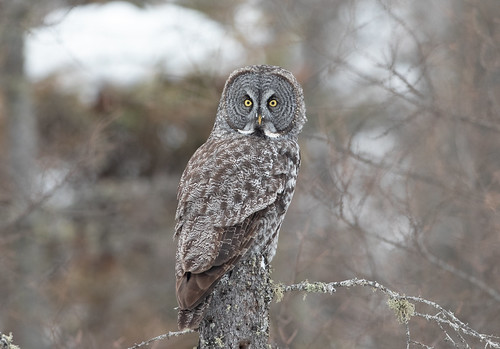Lots of birders have been spending time in the Sax-Zim Bog this winter, and many of them have had good luck finding owls. I’ve seen lots of people talking about “their” Great Gray, Barred, and Northern Hawk Owls. A few have seen a Short-eared or Great Horned Owl in the bog, and some people have even managed to see a Boreal Owl there. For one brief, shining moment, quite a few of us managed to see a Barn Owl—that poor thing was so far out of range that it almost certainly didn’t have a chance of surviving the winter even if it hadn’t been attacked by ravens. It was captured in a terribly emaciated state and didn’t survive being transported to the Raptor Center. They’ll do a necropsy to confirm exactly how the tragic wanderer died.
The fact that so many birders gravitate to the bog improves everyone’s chances of finding any owls that are around. Basic birder etiquette requires anyone going to a heavily birded place to share our birds. When we see someone looking at or photographing a bird, we pull over behind them and carefully, quietly approach, holding back at least a bit and keeping cars between us and the bird until the other person gives us a signal that it’s okay to come on over—we stay quiet and stop if the bird shows any sign of spooking.
 |
| Russ and I came upon this Great Gray Owl in the Bog last year. Lots of other birders joined us when they saw what we were looking at. |
Yesterday, I had a completely opposite experience—someone actually going out of his way to make sure I got a good bird. My good birding friend Greg Garmer called me about 11:30 to tell me he could see a Great Gray Owl from his apartment below the freeway at 21st Avenue East—right in the city, just a few miles from my house. The bird has been there for a couple of days now, hunting in a narrow strip of open field between the freeway and Water Street, perching in some spruces and on a sign. Bazillions of birders have come there—it’s easy to park off Water Street and the bird quickly figured out that the birders are staying out of the field itself, staying on the roadside watching quietly enough that they’re not interfering with the owl’s hunting. Great Gray Owls feed primarily on meadow voles, which they detect by ear—the voles live in grassy tunnels that are right now buried under deep snow. The owls can focus their big facial disks so well that they can pick up mousey sounds even with highway traffic zipping by constantly.
I spent 45 minutes or an hour with the bird—I’d just bought a new camera body I wanted to test out, and got not just good photos when the owl was perched but also good flight shots.
The light was fairly poor—I’ve pretty much forgotten what a sunny day looks like, it’s been so overcast lately—but I was thrilled, by my photos, of course, but especially by this magnificent bird who somehow is gracing Duluth’s waterfront for a few days.
It’s very scary seeing such a stunning but fragile creature as cars roared past, knowing there are a lot of dangers between this urban spot and anywhere genuinely wild.
Some people are talking about capturing and relocating it for its safety. The trick is that capturing a wild owl right next to a highway would not only be stressful for the bird but risk scaring the poor thing right into the path of those cars, and any place we relocated it would have its own dangers—some of the Great Gray Owls that have found good hunting areas in the open areas way out near Isabella or in the bog have ended up being killed by cars. We humans seem to think that we know more than wild birds do, and that a place we chose to put an owl in would of course be better than the one it found on its own. I’m sure we do understand the dangers of that place better than the owl does, but we may not understand the dangers of other places as well as the owl does, and we almost certainly don’t understand how stressful capture is under the best of circumstances. Relocating it is not a straightforward issue.
Meanwhile, this magnificent bird has managed to survive here for at least two days, making lots of us very nervous even as we’re thrilled to have seen it. We’re all hoping that one morning it simply won’t be there, nor will its body be found near the roadside. It’s such a joy to see such a thing anywhere, much less right in town, and when a living being brings so much pleasure to so many people, we can’t help but wish it well, hoping against hope that it lives long and prospers.








